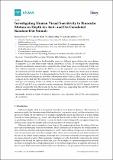Investigating human visual sensitivity to binocular motion-in-depth for anti- and de-correlated random-dot stimuli
Abstract
Motion-in-depth can be detected by using two different types of binocular cues: change of disparity (CD) and inter-ocular velocity differences (IOVD). To investigate the underlying detection mechanisms, stimuli can be constructed that isolate these cues or contain both (FULL cue). Two different methods to isolate the IOVD cue can be employed: anti-correlated (aIOVD) and de-correlated (dIOVD) motion signals. While both types of stimuli have been used in studies investigating the perception of motion-in-depth, for the first time, we explore whether both stimuli isolate the same mechanism and how they differ in their relative efficacy. Here, we set out to directly compare aIOVD and dIOVD sensitivity by measuring motion coherence thresholds. In accordance with previous results [1], we found that motion coherence thresholds were similar for aIOVD and FULL cue stimuli for most participants. Thresholds for dIOVD stimuli, however, differed consistently from thresholds for the two other cues, suggesting that aIOVD and dIOVD stimuli could be driving different visual mechanisms.
Citation
Giesel , M , Wade , A , Bloj , M & Harris , J 2018 , ' Investigating human visual sensitivity to binocular motion-in-depth for anti- and de-correlated random-dot stimuli ' , Vision , vol. 2 , no. 4 , 41 . https://doi.org/10.3390/vision2040041
Publication
Vision
Status
Peer reviewed
Type
Journal article
Description
This research was funded by BBSRC grants BB/M001660/1 (JH), BB/M002543/1 (AW), and BB/M001210/1 (MB).Collections
Items in the St Andrews Research Repository are protected by copyright, with all rights reserved, unless otherwise indicated.

